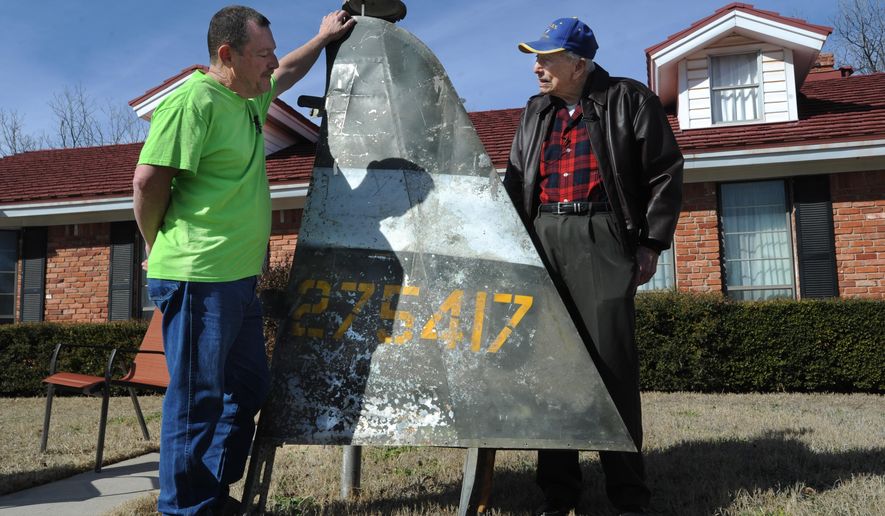ABILENE, Texas (AP) - “29 January 1944.”
At 93, Charlie Screws still can spout out that date crisply, in military style, anytime he’s asked about his harrowing experience as a P-47 Thunderbolt pilot during World War II.
It’s the way he begins recounting the story of how he and his Thunderbolt ended up in a beet field outside Dunkirk, France, after the plane was mortally wounded by flak from German fighter planes.
Screws thought he left that plane behind forever in then-occupied German territory, but he was reunited recently with the 6-foot tail section, battered and somewhat faded but with the stenciled yellow numbers 275417 still visible at the base.
“How about that!” Screws told the Abilene Reporter-News (https://bit.ly/1xB4KKD) as he gazed at the tail section in disbelief.
The entire plane was discovered about 20 years ago by two relic hunters in Europe, and the tail section recently was spotted online by Michael Fuller, an avid tracker of World War II aircraft who lives in California.
Fuller happened to know Malcolm Laing, director of a branch of the Texas Air Museum in Slaton, and contacted him. Laing knows Screws and soon a date was set to reunite the pilot with a part of his plane.
Earlier this month, the tail section was placed in Screw’s front yard in north Abilene as reporters and photographers gathered around.
“I would think it was all melted down,” Screws said, explaining that the Germans were known to melt parts of downed aircraft they discovered.
Laing will take the section with him so that it can be displayed at the museum in Slaton. But the memories will remain with Screws. Those memories began about noon Jan. 29, 1944, when Screws was returning to his base near Bottisham, England, as part of the 361st Fighter Group.
Screws was strafing targets on his way back when his plane was hit. He knew instinctively the plane was doomed.
“When everything quit,” he said, “I bellied the thing in.”
The belly landing was relatively gentle and Screws was not badly injured. He was more concerned about how tightly he was strapped into the plane. He feared the Nazis might be closing in and wanted to get out as quickly as possible.
Once he freed himself, he made his way into nearby timberland, dug a hiding place in the brush, and waited. He could hear the sounds of voices and work horses coming from a farm in the distance. At nightfall, he set out for the farm, hoping to find a sympathetic family.
“I knew to go to that direction,” he said.
The family was more than sympathetic. They located a woman who spoke English and she was able to get Screws on a train to Paris.
“I survived,” he said, and he continued his service with the Army Air Corps.
Screws eventually made his way to Abilene as a P-47 pilot instructor at the Abilene Army Air Base near Tye (the future Dyess Air Force Base).
After the war, Screws, a native of Little River near Temple, stayed in Abilene. Over the years he connected with Laing, director of the Texas Air Museum in Slaton, never dreaming that a part of his own plane might end up there.
But thanks to Fuller, the Californian who found the tail section online, the reunion took place recently almost 71 years since Screws had to ditch his plane. Fuller, a film and stage actor, spends his free time tracking down World War II aircraft. He and Laing, the museum director, restore vintage aircraft as a hobby. The minute Fuller saw the tail section online, he made arrangements to buy it and have it shipped to the United States.
“I knew what it was when I saw it,” Fuller said.
At a news conference at Screws’ Abilene home, Fuller, Screws’ son David Allison of Arlington and Laing shared the story. It was an emotional moment for Fuller, who spotted the tail section online and possibly saved it from the hands of someone trying to make a buck off treasured memorabilia.
“It’s an honor for me to be in the presence of someone who put his life on the line,” Fuller said.




Please read our comment policy before commenting.